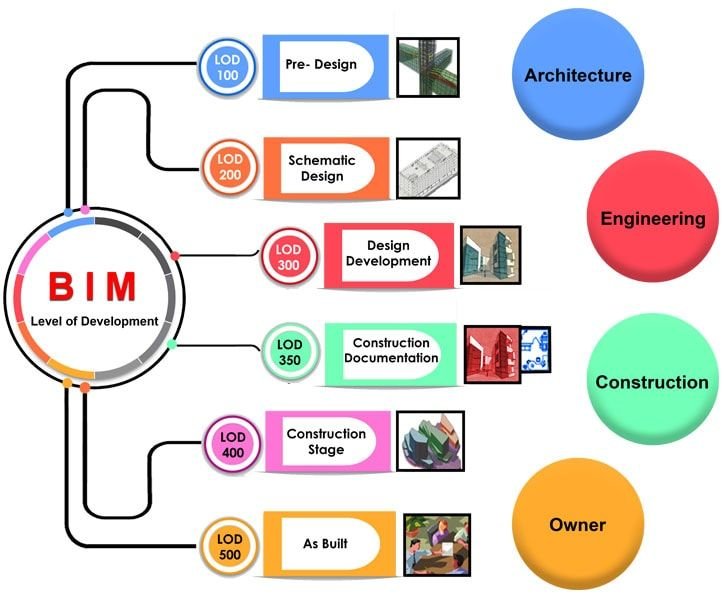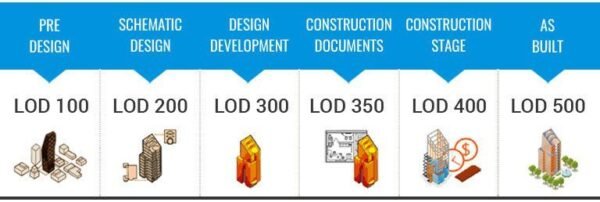
What is the Level of Development (LOD)?
Referred to as a lifecycle BIM tool, Level of Development (LOD) is a set of industry standards that provides the AEC industry the power to document, articulate, and specify the Building Information Modeling (BIM) contents properly and clearly. It defines the content (i.e., the geometric information, structured data, and linked documents) and the reliability of BIM elements at different development stages of the construction project.

Level of Development vs Level of Details
Level of Development
Level of Development (LOD) refers to the degree to which a building element’s geometry and associated information have been thought through and defined. It represents the completeness, accuracy, and reliability of the information at various stages of the design and construction process. Higher LOD levels indicate that the element has been modelled with greater precision and that its data can be relied upon for fabrication, installation, or cost estimation.
Level of Details
Level of Detail, on the other hand, focuses solely on the visual representation of a model element. It describes how detailed or complex the geometry appears in drawings or visual outputs, regardless of whether the underlying data is usable or accurate. An object may look highly detailed but may still lack the necessary development for real-world use.
BIM Level of Development (LOD) 100, 200, 300, 350, 400 & 500

The following sections detail each Level of Development (LOD) from 100 to 500, outlining their characteristics and typical uses in a construction project.

LOD 100
Pre-design Stage
It is the pre-designing stage of LOD.
Conceptual Model
The LOD 100 element is a conceptual model where the parameters such as height, area, volume, orientation, and location are defined.
Approximation
The information in this stage is considered as an approximation.
LOD 200
Schematic Designing Stage
It is the schematic designing stage of LOD.
Geometric Features
The LOD 200 element displays geometric features such as shapes, dimensions, locations, etc.
Slightly More Complex
The level of complexity in LOD 200 is slightly more than that of LOD 100. It may also include some non-geometric information.
Approximation
The information at this stage is also considered as an approximation.

LOD 300
It is the building design development stage of LOD.
The graphical representations of LOD 300 may be the same as the graphical representation of LOD 200, but what makes it different from LOD 200 is that the geometry and features at this stage are considered accurate.
The information at this stage can be used in the construction stage.
LOD 350
Construction Documentation Stage
It is the construction documentation stage.
Includes Interfaces
The information obtained in LOD 350 is the same as that obtained in LOD 300, but in this stage, the interfaces with other building components like connections and support are also included.
Installation and Interaction
It indicates the way the component can be installed and the way it interacts with the systems of other buildings.
LOD 400 & 500
LOD 400
It is the construction stage of LOD.
- It includes details such as fabrication, assembly, and installation of the components.
- These details are of great use to the suppliers for manufacturing the components that are represented.
- It may also include non-visual information.
LOD 500
It is the as-built stage of LOD.
- These are the fields that are verified in terms of shape, size, quantity, orientation, and location, which are considered to be accurate representations of the building elements post-construction.
- These elements can be used as references for operation and maintenance by the facility managers.
| 100 | Concept | Basic representation of building volumes or site layout. | Very general, no specific details. | Early-stage planning and visualization. |
| 200 | Approximate | General geometry and location of elements with rough sizes. | Basic shape and size information. | Preliminary design and cost estimation. |
| 300 | Detailed | Accurate dimensions and detailed design of building components. | Detailed geometry and placement. | Detailed design, construction drawings. |
| 350 | Construction | Detailed design with construction details, including how components fit together. | High detail with construction specifics. | Construction documentation and assembly. |
| 400 | As-Built | Reflects the completed project with actual construction details. | Accurate to the built conditions. | Facility management and future modifications. |
| 500 | Operational | Includes operational data and performance information of the building. | Most detailed with operational data. | Long-term maintenance and operations. |
Benefits of Level of Development (LOD)
The level of development is a vital element in the overall BIM process. Without it, the members working on a construction project may face difficulties working on the same page leading to inconsistencies that can damage the prospect of that project.
Conclusion
Understanding the Levels of Development (LOD) in BIM is essential for anyone involved in the architecture, engineering, or construction industries. From the early conceptual phases (LOD 100) to the as-built model (LOD 500), each stage provides a new level of detail and accuracy, guiding the project from start to finish. By utilizing the appropriate LOD, teams can ensure clear communication, better collaboration, and more successful project outcomes.
If you desire to have accurate and clash-free 3D models with Levels of Development stages from LOD 100 to 500 to enable the different construction teams involved in your construction project to articulate component geometry and information evolution, Monarch Innovation can be the right choice for you. It implements BIM projects for various construction tasks using Levels of Development from LOD 100 to 500 as per the needs and requirements. Contact Monarch Innovation to reduce your BIM risks with its LOD service.
FAQs
- LOD 100: Conceptual design, approximate geometry.
- LOD 200: Schematic design, generalized elements.
- LOD 300: Detailed design, specific elements with accurate size and shape.
- LOD 400: Fabrication and assembly details, accurate in terms of size, shape, location, and orientation.
- LOD 500: As-built conditions, an exact representation of the as-built elements.

